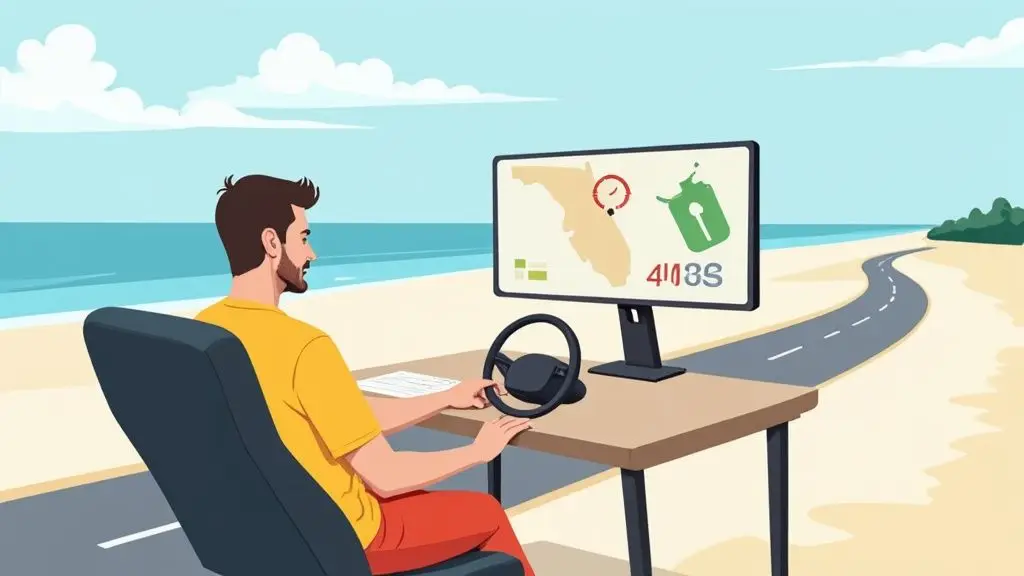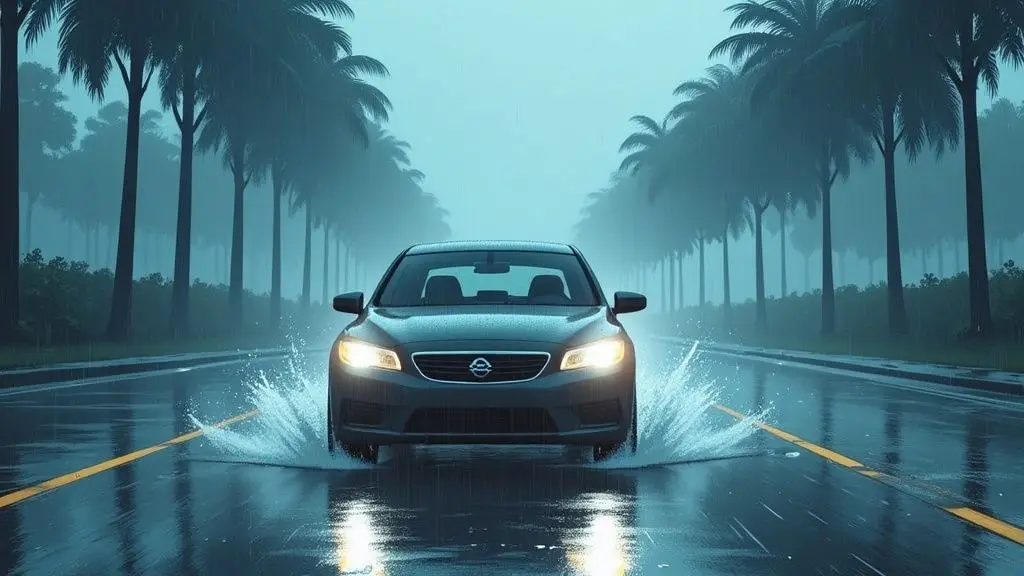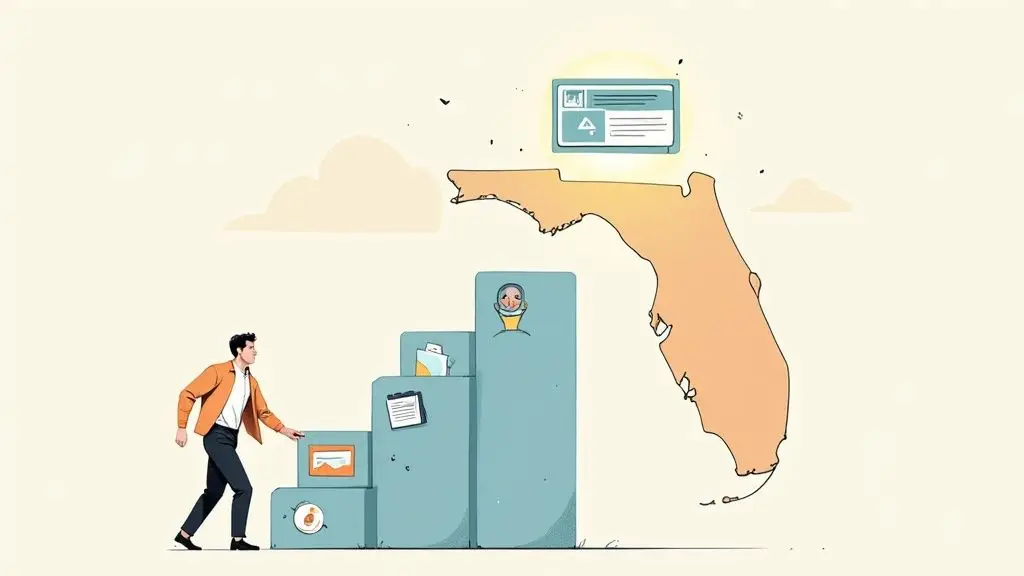Florida’s sudden downpours can transform a routine drive into a high-stakes challenge, turning familiar asphalt into a slick, unpredictable surface. While many drivers feel a false sense of security, statistics reveal a sharp increase in accidents the moment rain begins to fall. The key to staying safe isn’t just about slowing down; it’s about a proactive, strategic approach to every aspect of your driving, from tire maintenance to your lane position. A few seconds of inattention on wet roads can have lasting consequences.
This guide moves beyond the obvious, offering eight critical and actionable tips for driving in the rain designed specifically for Florida’s unique weather patterns. Mastering these techniques will not only protect you and your passengers but also build the kind of defensive driving skills that prevent incidents before they happen. You will learn precise following distances, how to spot and avoid hydroplaning risks, and why the first few minutes of a storm are often the most dangerous.
For drivers looking to deepen their understanding of road safety and potentially dismiss a recent traffic ticket, these principles are a cornerstone of the curriculum at BDISchool. We focus on turning everyday drivers into confident, all-weather experts.
1. Reduce Your Speed Significantly
Slowing down is the single most effective action you can take when driving in the rain. Water on the asphalt creates a barrier between your tires and the road surface, severely limiting traction. This lubrication effect means your vehicle needs a much longer distance to stop and is more prone to skidding, especially during sudden maneuvers.
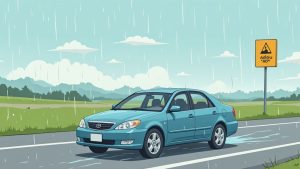
As a general rule, you should reduce your normal speed by at least one-third on wet roads. If you typically drive 60 mph on a Florida highway like I-95, you should aim for no more than 40 mph in the rain. In a torrential downpour, which is common during Florida’s summer storm season, an even greater speed reduction is necessary as visibility plummets and the risk of hydroplaning increases dramatically.
Why This Is The Most Critical Tip
Speed is the critical factor in the physics of driving. By reducing it, you give yourself more time to react, increase the effectiveness of your tires’ grip, and decrease the potential force of impact if a collision occurs.
Key Insight: The Washington State Patrol found that reducing highway speeds from 60 to 45 mph during heavy rain led to a 23% decrease in rain-related accidents. This demonstrates a direct and significant link between lower speeds and improved safety.
Actionable Ways to Control Your Speed
Implementing this crucial tip for driving in the rain requires conscious effort. Here are practical ways to ensure you slow down effectively:
- Cancel Cruise Control: The moment rain starts, disengage your cruise control. This action serves as a physical reminder to manually control your speed and remain more engaged with the changing road conditions.
- Use Your Wipers as a Trigger: Create a mental rule: if your wipers are on, your speed must be reduced. Let the rhythmic motion of the wiper blades be a constant reminder to check your speedometer.
- Beware of Auditory Masking: The sound of rain and tires on wet pavement can make it difficult to perceive your actual speed. Check your speedometer more frequently than you would in dry conditions.
- Anticipate Problem Areas: Be extra cautious on curves, bridges, and overpasses. These areas are notorious for water accumulation and can be slicker than straight sections of road.
Understanding the direct relationship between speed, traction, and stopping distance is a core principle of defensive driving. Mastering this and other advanced safety techniques is a key focus in a BDI (Basic Driver Improvement) course, which can help Florida drivers not only become safer but also potentially reduce insurance premiums.
2. Increase Following Distance to 5-6 Seconds
The standard 3-4 second following distance for dry conditions becomes dangerously inadequate in the rain. Wet roads can easily double your vehicle’s stopping distance, making it crucial to leave significantly more room between you and the car ahead. Increasing your buffer zone is a fundamental tip for driving in the rain that directly prevents rear-end collisions.
To apply this rule, choose a fixed object on the roadside, like a sign or a bridge. As the vehicle in front of you passes it, begin counting “one-thousand-one, one-thousand-two…” until your front bumper reaches the same object. In light rain, this count should reach at least five or six seconds. During Florida’s intense downpours, expanding this to 8-10 seconds provides the safest possible margin.
Why This Is A Critical Tip
Adequate following distance is your primary defense against sudden stops and unpredictable driver actions. Water on the road reduces tire friction, meaning your brakes need more time and distance to bring your car to a halt. A larger gap gives you the necessary reaction time and physical space to brake safely without skidding or colliding with the vehicle in front of you.
Key Insight: UPS mandates a 6-second following distance for its drivers during any precipitation. This policy alone was credited with reducing the company’s rain-related incidents by 41%, proving how effective a larger safety cushion is in real-world conditions.
Actionable Ways to Maintain a Safe Distance
Maintaining the correct following distance requires active concentration and breaking old habits. Here are practical methods to ensure you keep a safe gap:
- Use the Wiper Trigger: Similar to managing speed, make a conscious rule: if your wipers are on, your following distance doubles. This simple mental link helps build a consistent safety habit.
- Count Out Loud: Actively use the “one-thousand-one” counting method. Hearing yourself count makes you more aware of the actual time gap versus just estimating it visually.
- Resist Tailgating Pressure: If a driver behind you is too close, avoid speeding up. Maintain your safe distance from the car ahead and, if necessary, move to another lane when it is safe to let the tailgater pass.
- Re-establish Your Space: When another vehicle cuts into your safe following distance, don’t get frustrated. Gently ease off the accelerator and gradually slow down to re-create the 5-6 second buffer you need.
Mastering concepts like the 5-6 second rule is a core component of defensive driving. An online BDI course reinforces these life-saving habits, helping Florida drivers navigate challenging conditions like rain with greater confidence and skill.
3. Avoid Sudden Braking and Acceleration
Smooth, gradual inputs are critical when driving in the rain. Sudden changes in speed or direction can easily overwhelm your tires’ limited grip on wet surfaces, leading to skids or a complete loss of control. Wet roads can reduce available traction by 30-50%, meaning aggressive braking or acceleration that would be safe in dry conditions becomes extremely hazardous in the rain.
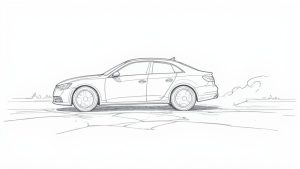
This principle of smoothness applies to all your vehicle’s controls: steering, braking, and acceleration. Each input should be applied progressively and gently. This allows the vehicle’s weight to transfer smoothly, keeping the tires in maximum contact with the road and preventing them from breaking traction. Abrupt movements can disrupt this delicate balance instantly.
Why This Is The Most Critical Tip
Traction is finite, and in the rain, there’s much less of it to work with. Sudden inputs demand more grip than your tires can provide, causing them to slip. Mastering smooth control is the difference between navigating a wet curve safely and spinning into a dangerous situation. It’s a fundamental aspect of car control that becomes non-negotiable in poor weather.
Key Insight: Professional driving schools like the Skip Barber Racing School have demonstrated that smooth driver inputs in rainy conditions can improve lap times by as much as 8-12% over jerky, reactive corrections. This highlights how smoothness directly translates to better control and safety.
Actionable Ways to Control Your Inputs
Making your driving smoother requires conscious practice. Here are practical methods to implement this essential tip for driving in the rain:
- Visualize a Full Cup: Imagine a full cup of hot coffee sitting on your dashboard. Drive in a way that prevents it from spilling. This mental exercise encourages gentle acceleration, smooth braking, and careful steering.
- Look and Plan Farther Ahead: Increase your following distance significantly and scan the road far ahead. This gives you much more time to anticipate stops and slowdowns, allowing you to brake earlier and more gradually.
- “Squeeze” the Pedals: Instead of stomping on the brake or gas, think of gently squeezing them. Apply pressure progressively to avoid locking the wheels or causing them to spin. If you feel a slip, ease off immediately and reapply more gently.
- Utilize Engine Braking: Help slow the car down naturally by lifting your foot off the accelerator earlier than usual. If you drive a manual transmission, you can downshift to a lower gear to assist with slowing down before applying the brakes.
4. Turn On Headlights and Maintain Proper Visibility
Proper visibility management in the rain is a two-way street: it’s about seeing the road clearly and ensuring other drivers can see you. Rain, mist, and road spray create a grey, low-contrast environment where vehicles can easily blend into the background. Activating your full headlights, not just daytime running lights, is essential for cutting through this gloom and making your presence known.
In Florida, the law is clear: if your windshield wipers are on, your headlights must be on. This simple rule dramatically increases your vehicle’s visibility to others, reducing the risk of collisions. Visibility isn’t just about lights; it’s also about a clear view from the driver’s seat. Worn wipers, a dirty windshield, or interior fog can be just as dangerous as the storm outside.
Why This Is The Most Critical Tip
Impaired visibility is a primary cause of accidents during inclement weather. By taking active steps to see and be seen, you directly counteract the hazardous conditions created by the rain, giving yourself and others the crucial reaction time needed to navigate safely.
Key Insight: Studies from Scandinavian countries, where daytime headlight use is mandatory, have shown a nearly 15% reduction in multi-vehicle accidents during rainy conditions. This highlights the profound safety impact of making your vehicle more conspicuous.
Actionable Ways to Maintain Visibility
Implementing this tip for driving in the rain involves more than just flipping a switch. Here are practical ways to ensure you maintain a clear line of sight:
- Use the Right Lights: Always turn on your low-beam headlights. Never use high beams in rain or fog, as the light will reflect off the water droplets, creating glare and worsening your visibility.
- Maintain Your Wipers: Replace wiper blades every 6-12 months or as soon as they start streaking or skipping. For enhanced performance, consider applying a hydrophobic windshield treatment like Rain-X, which causes water to bead up and roll off.
- Fight Interior Fog: Prevent condensation by running your car’s defrost setting with the A/C on. The air conditioning system acts as a dehumidifier, quickly clearing moisture from the inside of your glass.
- Keep Glass Clean: Beyond turning on your headlights, ensuring your windshield is crystal clear is paramount. Addressing minor damage promptly with professional windshield repair is crucial to prevent cracks from spreading and obscuring your vision.
Understanding how to manage your vehicle’s lighting and visibility systems is just as important as knowing how to handle the car in low-traction situations. These principles are closely related to the skills needed for safe night driving. For more comprehensive strategies, you can explore these night driving safety tips.
5. Avoid Hydroplaning Through Proper Tire Maintenance and Awareness
Hydroplaning is one of the most dangerous situations a driver can face in the rain. It occurs when a layer of water builds up between your tires and the road surface, causing a complete loss of traction and control over steering and braking. This frightening phenomenon can begin at speeds as low as 35 mph, especially if your tires are worn and the water depth is sufficient.
Prevention is a two-part strategy: proactive vehicle maintenance and reactive driver awareness. Properly maintained tires with adequate tread depth and pressure are your first and best defense, acting like channels to siphon water away. Combined with a driver’s ability to spot and react to high-risk areas, you can significantly reduce the chances of losing control.
Why This Is The Most Critical Tip
Losing steering control, even for a split second, can lead to a catastrophic accident. Hydroplaning is not a partial loss of traction; it is a total disconnection from the road surface, effectively turning your car into an uncontrolled sled. Understanding how to prevent it, and what to do if it happens, is a non-negotiable skill for safe driving.
Key Insight: A Washington State Department of Transportation study found that 38% of rain-related crashes involved vehicles with inadequate tire tread. This highlights the direct and critical link between tire condition and your safety on wet Florida roads.
The following infographic visualizes the key data points related to hydroplaning prevention, including minimum tire tread depth, speed thresholds, and water displacement rates.
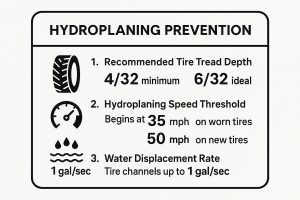
This data shows that having the right tire tread is crucial, as is keeping your speed below the hydroplaning threshold, which can be as low as 35 mph.
Actionable Ways to Avoid and Manage Hydroplaning
Preventing a hydroplane event is far better than reacting to one. Here are the most effective tips for driving in the rain to keep your tires firmly on the pavement:
- Perform the Penny Test: Use a simple penny to check your tread depth. Insert it into a tread groove with Lincoln’s head upside down. If you can see the top of his head, your tread is below the safe minimum of 2/32″ and the tires need immediate replacement. For rain, a depth of 4/32″ is recommended.
- Maintain Tire Pressure: Check your tire pressure monthly when the tires are cold. Properly inflated tires make full contact with the road and channel water most effectively.
- Know How to React: If you feel the car begin to hydroplane (light steering, engine revs up), do not panic. Ease your foot off the accelerator and do not brake or turn the wheel. Keep the steering wheel straight and wait for the tires to regain traction, which usually happens in a second or two.
- Scan the Road Ahead: Actively look for and avoid large puddles, standing water, and running water across the road. Drive in the tracks left by the vehicle ahead of you, as their tires have already displaced some of the water.
Mastering defensive techniques like these is essential for staying safe. You can learn more about these driving safety tips for rain and how they apply to Florida’s unique weather conditions.
6. Use Proper Lane Positioning and Avoid Standing Water
Strategic lane positioning is a proactive defensive driving technique for managing wet road conditions. Because roads are crowned for drainage, water naturally flows to the edges and collects in the outer ruts worn by heavy traffic. By positioning your vehicle more towards the center of a lane or using the middle lane on a multi-lane highway, you can often drive on slightly higher, drier pavement, which significantly improves tire grip.
This principle extends to avoiding areas where water accumulates, such as underpasses, low-lying intersections, and the curb lanes. Even a few inches of standing water can cause a vehicle to lose control or stall, and its depth can be dangerously deceptive. Avoiding these hazards altogether by choosing a better path is a key part of safely driving in the rain.
Why This Is The Most Critical Tip
Improper lane positioning leads directly to hydroplaning and loss of vehicle control. The deepest water is often invisible at night or in heavy downpours, making your choice of lane a critical decision. By actively scanning the road ahead and understanding where water collects, you can maintain traction and prevent your vehicle from being pulled unexpectedly by deep puddles.
Key Insight: FedEx trains its drivers to favor center lanes during rain, a practice they credit with a 28% reduction in hydroplaning incidents across their fleet. This highlights how a simple, conscious choice in positioning can yield major safety benefits.
Actionable Ways to Position Your Vehicle
Implementing this tip for driving in the rain requires you to think like a water drainage engineer. Here are practical ways to find the safest path:
- Favor the Center Lane: On highways with three or more lanes, the center lane is often the best-drained and has less wear, making it the driest option.
- “Read” the Road Surface: Watch the tire tracks of vehicles ahead. If they are kicking up immense amounts of spray, they are driving through deep water. Adjust your path to follow a drier line.
- Approach Puddles with Caution: If standing water is unavoidable, slow down dramatically before you enter it, not while in it. Drive through at a steady, slow speed (5-10 mph) without braking.
- Dry Your Brakes: After exiting a deep puddle, gently tap your brakes a few times. This action helps squeeze water from the pads and rotors, restoring their normal stopping power.
Knowing how to read the road and position your vehicle for maximum safety is a skill that separates average drivers from excellent ones. These nuanced techniques are explored in depth in a Florida BDI course, helping drivers master the art of anticipating and neutralizing hazards before they become emergencies.
7. Exercise Extra Caution During First Rain After Dry Period
The most treacherous time to drive in the rain is often within the first 30 minutes. After a dry spell, common in Florida, roads accumulate a buildup of oil, grease, tire rubber, and other fluids. When rain first begins, it mixes with this residue, creating a slick, greasy film that dramatically reduces traction before heavier rainfall can wash the roadway clean.

This phenomenon makes the road surface almost as slippery as ice, with some studies showing friction can decrease by as much as 70%. This initial period is often more dangerous than a sustained downpour because the hazard is less obvious to unsuspecting drivers, making it a critical tip for driving in the rain.
Why This Is The Most Critical Tip
This tip is vital because it addresses a hidden danger. While most drivers know to slow down in a heavy storm, the danger of a light, initial rain is often underestimated. The invisible slickness catches drivers by surprise, leading to a sharp increase in skids, spinouts, and collisions precisely when people are least prepared.
Key Insight: The California Highway Patrol regularly reports a spike in accidents during the first 30 minutes of the season’s initial rainfalls. Similarly, a AAA study found that crashes during the first rain increased by 34% in dry-climate states, highlighting the severe risk this condition presents.
Actionable Ways to Handle the First Rain
Recognizing and responding to this specific threat requires a heightened state of alert and a more defensive driving posture. Here are precise actions to take:
- Drastically Reduce Speed: Your speed reduction should be more significant than in normal rain. Aim to decrease your speed by 40-50%, not just one-third.
- Increase Following Distance: Double your normal safe following distance. Instead of a 4-5 second gap, aim for an 8-10 second gap to give yourself ample time to stop on the slick surface.
- Minimize Maneuvers: Avoid any sudden lane changes, acceleration, or braking for at least the first 20 minutes of rain. Be especially gentle on curves, ramps, and at intersections where oil buildup is heaviest.
- Be Aware of Vulnerable Road Users: The slick film is exceptionally dangerous for motorcyclists and bicyclists. Give them extra space, as they are far more susceptible to losing traction.
Understanding these specific, high-risk scenarios is a cornerstone of advanced driver safety. A BDI (Basic Driver Improvement) course delves into such nuanced conditions, equipping Florida drivers with the knowledge to anticipate and manage hidden road hazards effectively.
8. Pull Over Safely if Conditions Become Too Hazardous
Sometimes, the most proactive safety measure you can take is to stop driving altogether. Florida’s intense, sudden downpours can reduce visibility to near zero in seconds, making it impossible to see lane markings, other vehicles, or road hazards. If your wipers at their highest speed can’t keep the windshield clear or if you feel overwhelmed by the conditions, pulling over isn’t a sign of weakness; it’s the smartest decision you can make.
The key is to do so safely. Never stop in a travel lane or on the shoulder of a major highway like the Florida Turnpike unless it is an absolute emergency. Instead, your goal should be to reach the nearest exit, rest area, or commercial parking lot where you can wait out the worst of the storm away from fast-moving traffic. No destination is worth risking your life in a low-visibility, high-risk situation.
Why This Is The Most Critical Tip
Ego and schedules can be dangerous partners in severe weather. Continuing to push through a torrential storm puts you and everyone around you in jeopardy. Professional drivers for companies like UPS and FedEx are trained to pull over when visibility drops below safe operating levels. Adopting this professional mindset prioritizes safety above all else.
Key Insight: The Federal Motor Carrier Safety Administration (FMCSA) advises commercial drivers that if they feel their driving is unsafe due to weather, “they should not be driving.” This same principle applies to all motorists; your personal judgment of safety is the ultimate deciding factor.
Actionable Ways to Pull Over Safely
Knowing when and how to stop is a critical skill for driving in the rain. Here are practical steps to take when conditions become too hazardous:
- Prioritize Exits, Not Shoulders: Use your GPS to find the next exit with a gas station, rest area, or shopping center. These are safe havens away from highway traffic. Stopping on a highway shoulder should be a last resort.
- Maximize Your Visibility: Once safely stopped, turn on your hazard lights (emergency flashers) immediately to alert other drivers to your stationary vehicle.
- Stay Secured in Your Vehicle: Do not exit your car, especially on a highway shoulder. Remain in your vehicle with your seatbelt fastened. In a thunderstorm, a car’s metal frame can offer protection from lightning strikes.
- Assess and Communicate: Use a weather app on your phone to check the radar and see how long the storm might last. Notify anyone expecting you that you have stopped for safety and will be delayed.
Understanding how to react to extreme weather is a cornerstone of advanced defensive driving. You can learn more about managing these challenging scenarios by exploring resources on driving safety during severe weather in Florida, which provides crucial knowledge for navigating the state’s unpredictable climate.
8 Key Tips for Safe Rain Driving
| Safety Tip | Implementation Complexity 🔄 | Resource Requirements ⚡ | Expected Outcomes 📊 | Ideal Use Cases 💡 | Key Advantages ⭐ |
|---|---|---|---|---|---|
| Reduce Your Speed Significantly | Low – consistent speed adjustment | None | Decreases stopping distance up to 50%, reduces hydroplaning risk | Wet roads, heavy rain, reduced visibility | Most effective, no cost, better control |
| Increase Following Distance to 5-6 Seconds | Moderate – constant distance monitoring | None | Dramatically reduces rear-end collisions, improves visibility | General rain driving, low visibility, congested traffic | Reduces collisions, lowers stress, smoother driving |
| Avoid Sudden Braking and Acceleration | Moderate – requires driver discipline | None | Reduces skid/spin risk, improves fuel economy and vehicle stability | All wet conditions, especially slippery roads | Extends brake/tire life, predictable vehicle behavior |
| Turn On Headlights and Maintain Proper Visibility | Low – remembrance and maintenance | Regular wiper/washer upkeep | Improves visibility by 200-300 ft; reduces collision risk by 47% | Any rainy or low-light condition | Immediate visibility improvement, legally required |
| Avoid Hydroplaning Through Proper Tire Maintenance and Awareness | Moderate – routine tire checks | Regular tire replacement costs | Prevents 90% of hydroplaning incidents, better handling | Wet roads, long periods of rain, highway speeds | Critical for safety, improves fuel efficiency |
| Use Proper Lane Positioning and Avoid Standing Water | Moderate – ongoing road assessment | None | Reduces hydroplaning risk, improves escape route options | Roads with variable water pooling, bridges, overpasses | Strategic hazard avoidance, better traction |
| Exercise Extra Caution During First Rain After Dry Period | Moderate – heightened awareness | None | Reduces accident spike by 21-34%, treats road as extremely slippery | Initial rain after dry spells, summer/fall dry climates | Awareness lowers risk at most dangerous time |
| Pull Over Safely if Conditions Become Too Hazardous | Low – decision making and planning | Safe parking locations needed | Eliminates rain-related accident risk during stop | Torrential rain, poor visibility, driver anxiety | Absolute safety, reduces liability, mental rest |
Turn Rainy Day Risks into Safer Driving Habits
Navigating Florida’s frequent downpours doesn’t have to be a stressful or dangerous ordeal. The journey from cautious uncertainty to confident control begins with transforming knowledge into action. The collection of tips for driving in the rain we’ve explored provides a comprehensive framework for proactive, defensive driving, turning potential hazards into manageable situations. Each strategy is a vital component of a larger safety system you command from behind the wheel.
Think of these principles not as a simple checklist but as interconnected habits. Reducing your speed gives you the time needed to maintain a greater following distance. That increased buffer, in turn, allows for the smooth, deliberate braking and acceleration required to prevent skids. This synergy is the core of defensive driving; one good habit reinforces another, creating a cascade of safer choices that protect you, your passengers, and others on the road.
Key Takeaways for Safer Wet-Weather Driving
Mastering the road during a storm means internalizing these core concepts:
- Anticipation Over Reaction: The most critical takeaway is to shift your mindset from reacting to hazards to anticipating them. This includes recognizing the increased risk of hydroplaning before you hit a puddle, understanding that the first rain creates exceptionally slick roads, and giving other drivers extra space because you anticipate their potential mistakes.
- Visibility is a Two-Way Street: Your headlights are not just for you to see; they are crucial for others to see you. Maintaining clear windshields, functional wipers, and activated headlights is a non-negotiable aspect of wet-weather safety that directly impacts everyone’s awareness.
- Your Vehicle is Your Partner: Proper vehicle maintenance, especially tire pressure and tread depth, is your first line of defense against losing control. You can be the most skilled driver, but if your equipment isn’t prepared for the conditions, your safety is compromised.
- Knowing When to Stop is as Important as Knowing How to Go: One of the most powerful decisions a driver can make is to pull over when conditions exceed their comfort level or the vehicle’s capability. Recognizing the point of diminishing returns, where the risk of continuing outweighs the benefit, is a sign of a truly mature and responsible driver.
Ultimately, these tips for driving in the rain are more than just rules for a rainy day; they are foundational principles of attentive and responsible driving that apply in any condition. By consciously practicing them, you are not just getting through the storm. You are actively building a skill set that makes you a safer, more confident, and more capable driver every time you get behind the wheel. The goal is to make these actions so instinctual that they become second nature, ensuring your safety, rain or shine.
Ready to formalize these skills and earn benefits like ticket dismissal and lower insurance rates? The state-approved courses at BDISchool are designed to reinforce these life-saving habits through engaging, flexible online modules. Enroll today at BDISchool to take the definitive next step in mastering Florida’s roads, no matter the weather.
